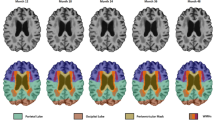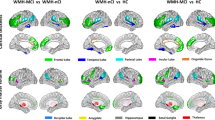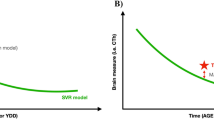Abstract
The contrast between gray and white matter in MRI is critical for accurately measuring cortical thickness. The gray/white matter intensity ratio (GWIR) has been proposed to be an important adjustment factor for cortical thickness measures in Alzheimer’s disease (AD) and mild cognitive impairment (MCI). This study examined the GWIR and its influence on cortical thickness in normal aging, mild cognitive impairment (MCI), and AD. The ability for GWIR to discriminate between these groups was assessed on its own and as an adjustment factor for cortical thickness. Minimal age- and AD-related changes in GWIR were observed. GWIR was not able to differentiate between normal aging, MCI, and AD. However, adjusting cortical thickness for GWIR slightly improved the ability to discriminate between groups and the effect size of cortical thickness increased after adjusting for GWIR. This work demonstrates the ambiguity in adjusting cortical thickness measures for GWIR, particularly when attempting to discriminate between normal aging, MCI, and AD groups.

Similar content being viewed by others
References
2013 Alzheimer’s disease facts and figures. (2013). . Alzheimer’s & Dementia 9:208–245.
Dale, A. M., Fischl, B., & Sereno, M. I. (1999). Cortical surface-based analysis I. Segmentation and surface reconstruction. NeuroImage, 9, 179–194.
DeLong, E. R., DeLong, D. M., & Clarke-Pearson, D. L. (1988). Comparing the areas under two or more correlated receiver operating characteristic curves: a nonparametric approach. Biometrics, 44, 837–845.
Desikan, R. S., Ségonne, F., Fischl, B., Quinn, B. T., Dickerson, B. C., Blacker, D., et al. (2006). An automated labeling system for subdividing the human cerebral cortex on MRI scans into gyral based regions of interest. NeuroImage, 31, 968–980.
Fischl, B., & Dale, A. M. (2000). Measuring the thickness of the human cerebral cortex from magnetic resonance images. Proceedings of the National Academy of Sciences, 97, 11050–11055.
Fischl, B., Sereno, M. I., Dale, A. M. (1999). Cortical surface-based analysis - II: Inflation, flattening, and a surface-based coordinate system [WWW Document]. URL: http://discovery.ucl.ac.uk/145122/ (accessed 9.21.11).
Fischl, B., Salat, D. H., Busa, E., Albert, M., Dieterich, M., Haselgrove, C., et al. (2002). Whole brain segmentation. Neuron, 33, 341–355.
Fischl, B., Salat, D. H., Van der Kouwe, A. J. W., Makris, N., Ségonne, F., Quinn, B. T., et al. (2004a). Sequence-independent segmentation of magnetic resonance images. NeuroImage, 23(Suppl 1), S69–S84.
Fischl, B., Van der Kouwe, A., Destrieux, C., Halgren, E., Ségonne, F., Salat, D. H., et al. (2004b). Automatically parcellating the human cerebral cortex. Cerebral Cortex, 14, 11–22.
Gómez-Isla, T., Hollister, R., West, H., Mui, S., Growdon, J. H., Petersen, R. C., et al. (1997). Neuronal loss correlates with but exceeds neurofibrillary tangles in Alzheimer’s disease. Annals of Neurology, 41, 17–24.
Grignon, Y., Duyckaerts, C., Bennecib, M., & Hauw, J.-J. (1998). Cytoarchitectonic alterations in the supramarginal gyrus of late onset Alzheimer’s disease. Acta Neuropathologica, 95, 395–406.
Grydeland, H., Westlye, L. T., Walhovd, K. B., Fjell, A. M. (2012). Improved prediction of Alzheimer’s disease with longitudinal white matter/gray matter contrast changes. Human Brain mapping.
Jack, C. R., Jr., Bernstein, M. A., Fox, N. C., Thompson, P., Alexander, G., Harvey, D., et al. (2008). The Alzheimer’s disease neuroimaging initiative (ADNI): MRI methods. Journal of Magnetic Resonance Imaging, 27, 685–691.
Salat, D. H., Lee, S. Y., Van der Kouwe, A. J., Greve, D. N., Fischl, B., & Rosas, H. D. (2009). Age-associated alterations in cortical gray and white matter signal intensity and gray to white matter contrast. NeuroImage, 48, 21–28.
Salat, D. H., Chen, J. J., Van der Kouwe, A. J., Greve, D. N., Fischl, B., & Rosas, H. D. (2011). Hippocampal degeneration is associated with temporal and limbic gray matter/white matter tissue contrast in Alzheimer’s disease. NeuroImage, 54, 1795–1802.
Westlye, L. T., Walhovd, K. B., Dale, A. M., Espeseth, T., Reinvang, I., Raz, N., et al. (2009). Increased sensitivity to effects of normal aging and Alzheimer’s disease on cortical thickness by adjustment for local variability in gray/white contrast: a multi-sample MRI study. NeuroImage, 47, 1545–1557.
Acknowledgments
The authors particularly thank the ADNI volunteer participants. Data collection and sharing for this project was funded by the Alzheimer’s Disease Neuroimaging Initiative (ADNI) (National Institutes of Health Grant U01 AG024904). ADNI is funded by the National Institute on Aging, the National Institute of Biomedical Imaging and Bioengineering, and through generous contributions from the following: Abbott; Alzheimer’s Association; Alzheimer’s Drug Discovery Foundation; Amorfix Life Sciences Ltd.; AstraZeneca; Bayer HealthCare; BioClinica, Inc.; Biogen Idec Inc.; Bristol-Myers Squibb Company; Eisai Inc.; Elan Pharmaceuticals Inc.; Eli Lilly and Company; F. Hoffmann-La Roche Ltd and its affiliated company Genentech, Inc.; GE Healthcare; Innogenetics, N.V.; IXICO Ltd.; Janssen Alzheimer Immunotherapy Research & Development, LLC.; Johnson & Johnson Pharmaceutical Research & Development LLC.; Medpace, Inc.; Merck & Co., Inc.; Meso Scale Diagnostics, LLC.; Novartis Pharmaceuticals Corporation; Pfizer Inc.; Servier; Synarc Inc.; and Takeda Pharmaceutical Company. The Canadian Institutes of Health Research is providing funds to support ADNI clinical sites in Canada. Private sector contributions are facilitated by the Foundation for the National Institutes of Health (www.fnih.org). The grantee organization is the Northern California Institute for Research and Education, and the study is coordinated by the Alzheimer’s Disease Cooperative Study at the University of California, San Diego. ADNI data are disseminated by the Laboratory for NeuroImaging at the University of California, Los Angeles. This research was also supported by NIH grants P30 AG010129 and K01 AG030514.
Disclosure statement
The authors have no actual or potential conflicts of interest to disclose.
Author information
Authors and Affiliations
Consortia
Corresponding author
Additional information
Data used in the preparation of this article were obtained from the Alzheimer’s Disease Neuroimaging Initiative (ADNI) database (http://www.loni.ucla.edu/ADNI). As such, the investigators within the ADNI contributed to the design and implementation of ADNI and/or provided data but did not participate in analysis or writing of this report. ADNI investigators include (complete listing available at: http://adni.loni.ucla.edu/wp-content/uploads/how_to_apply/ADNI_Authorship_List.pdf).
Electronic supplementary material
Below is the link to the electronic supplementary material.
Supplemental table 1
Cortical thickness models for predicting a) all three groups, b) MCI vs. normal aging, c) AD vs. normal aging, and d) AD vs. MCI. The c-statistics indicate the ability of the model to discriminate between the subject groups. Point estimates with 95 % confidence intervals are presented. STS = superior temporal sulcus. (XLSX 19 kb)
Supplemental table 2
GWIR-corrected cortical thickness models for predicting a) all three groups, b) MCI vs. normal aging, c) AD vs. normal aging, and d) AD vs. MCI. The c-statistics indicate the ability of the model to discriminate between the subject groups. Point estimates with 95 % confidence intervals are presented. STS = superior temporal sulcus. (XLSX 184 kb)
Rights and permissions
About this article
Cite this article
Bauer, C.M., Cabral, H.J., Killiany, R.J. et al. It is unclear if adjusting cortical thickness for changes in gray/white matter intensity ratio improves discrimination between normal aging, MCI, and AD. Brain Imaging and Behavior 8, 133–140 (2014). https://doi.org/10.1007/s11682-013-9268-6
Published:
Issue Date:
DOI: https://doi.org/10.1007/s11682-013-9268-6




